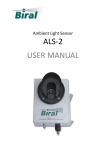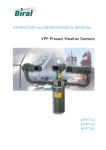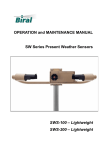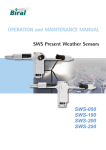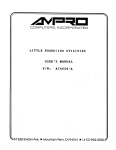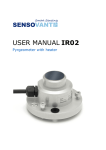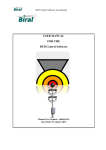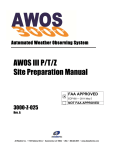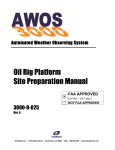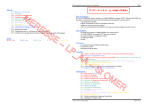Download ALS-2 USER MANUAL
Transcript
Ambient Light Sensor ALS -2 USER MANUAL [INTENTIONALLY BLANK] ii Produced by: Bristol Industrial and Research Associated Limited (BIRAL), P. O. Box 2, Portishead, Bristol, BS20 7JB, UK. Email: [email protected] Webpage: http://www.sensovant.com Tel: (+34) 96 816 2005 - (+34) 96 111 3302 This manual describes the installation and operation of the Biral ambient light sensor ALS-2 and calibrator and should be read fully before the instrument is used. If there are any questions about the equipment supplied or the instructions contained within this manual please consult Biral at the above address. To assist Biral in the event of questions could you please indicate the equipment type (and serial number if applicable), nature of your question, approximate number of hours in use and your return contact details. Copyright Declaration The information contained within this manual (including all illustrations, drawings, schematics and parts list) is proprietary of Biral. It is provided for the sole purpose of aiding the buyer or user in the operation and maintenance of the instrument. This information is not to be used for the manufacture or sales support of similar items without the express written permission of Biral, nor is it to be communicated to any third party without the express written permission of Biral. In the event that written permission is provided by Biral to disseminate any of the information contained within this document (in whatever form), this page (including this copyright declaration) must be attached. © Bristol Industrial and Research Associates Limited (Biral) 2012 This manual does not create nor include any legally binding obligation for Biral or its customers and end users. This documentation (and any attached appendices) is for customer information only. All information contained in this manual is correct (to the best knowledge of Biral) at the time of publication. Biral reserves the right to revise this manual without notification. The Equipment is CE marked and as such is deemed safe for use under normal operating conditions. Failure to comply with these conditions may result in personal injury not covered by the CE classification. Manual Number: Revision: 106134 00A iii TABLE OF CONTENTS 1 2 PRODUCT DESCRIPTION ............................................................................................ 1 INSTALLATION .............................................................................................................. 2 2.1 Configuration Options .............................................................................................................................. 5 2.1.1 Standalone Connection details ............................................................................................................. 5 2.1.2 Operating State Configuration options ................................................................................................ 5 3 MAINTENANCE .............................................................................................................. 7 4 DATA OUTPUT ................................................................................................................ 9 3.1 3.2 3.3 4.1 4.2 4.3 5 6 6.1 7 De-mister window heater (fitted as standard to all sensors) ................................................................. 7 Hood heater (optional) .............................................................................................................................. 7 Window Cleaning ...................................................................................................................................... 8 Operational Data Message - ALS-D? ...................................................................................................... 9 Remote Maintenance Monitor Message - ALS-R? ............................................................................... 10 Analog Output ......................................................................................................................................... 11 CALIBRATION .............................................................................................................. 11 SPECIFICATIONS ......................................................................................................... 14 Digital Communication Interface .......................................................................................................... 15 APPENDIX – ALS COMMUNICATION ..................................................................... 16 7.1 Command Line Interface ....................................................................................................................... 16 7.2 Standard Commands and Responses .................................................................................................... 16 7.2.1 ALS-ADR? – Get RS485 Sensor Address ......................................................................................... 16 7.2.2 ALS-ADRxx - Set RS485 Sensor Address ........................................................................................ 16 7.2.3 ALS-D? - Operational Message......................................................................................................... 16 7.2.4 ALS-DHO - Hood Heater on ............................................................................................................. 16 7.2.5 ALS-DHX - Hood Heater off ............................................................................................................ 17 7.2.6 ALS-OSAM? – Get Automatic Message Operating Settings ............................................................ 17 7.2.7 ALS-OSAMx – Set Automatic Message Operating Settings ............................................................ 17 7.2.8 ALS-OSCS? – Get Communication Operating Settings ................................................................... 17 7.2.9 ALS-OSCSx – Set Communication Operating Settings .................................................................... 17 7.2.10 ALS-OSHH? – Get Hood Heater Operating Settings ................................................................... 17 7.2.11 ALS-OSHHx – Set Hood Heater Operating Settings ................................................................... 17 7.2.12 ALS-OSWC? – Get Window Contamination Operating Settings................................................. 18 7.2.13 ALS-OSWCx – Set Window Contamination Operating Settings ................................................. 18 7.2.14 ALS-OSWH? – Get Window Heater Operating Settings ............................................................. 18 7.2.15 ALS-OSWHx – Set Window Heater Operating Settings .............................................................. 18 7.2.16 ALS-PV? – Program Version ....................................................................................................... 18 7.2.17 ALS-R? - Remote Maintenance Message ..................................................................................... 18 7.2.18 ALS-RST - Reset sensor ............................................................................................................... 18 7.2.19 ALS-SETCOM1,x - COM1 Baudrate Selection Routine ............................................................. 19 7.2.20 ALS-SNUM? Query Serial Number ............................................................................................. 19 7.2.21 ALS-WHO - Window Heater on .................................................................................................. 19 7.2.22 ALS-WHX - Window Heater off .................................................................................................. 19 7.3 Sensor Responses..................................................................................................................................... 20 7.4 RS485 Configuration .............................................................................................................................. 20 iv TABLE OF FIGURES Figure 1: Main components of the Biral ALS-2 .................................................................... 2 Figure 2: Biral ALS-2 installation on vertical pole ............................................................... 4 Figure 3: Schematic of junction box for Biral ALS-2 and SWS sensor .............................. 4 Figure 4: Hood Heater (optional) ........................................................................................... 7 Figure 5: Biral ALS-2 calibration unit ................................................................................. 13 Figure 6: Calibrator connected to ALS-2 whilst mounted on a pole ................................. 13 Table 1: Connections for RS 232 configured Model ............................................................. 3 Table 2: Connections for RS 422/485 configured Model ...................................................... 3 Table 3: Connections for Analog Output configured Model ................................................ 3 Table 4: Calibrator LED indicator patterns ........................................................................ 12 Table 5: Digital Communication Interface Specifications.................................................. 15 v SAFETY The Equipment does not pose a safety risk to the user when operated under normal conditions as described in this manual. However, the user is referred to the safety information below which details the potential risks if the equipment is not operated as intended. Warning The optional calibrator equipment contains a Nickel-Cadmium (NiCad) battery, which can be accessed if disassembled. DO NOT disassemble the calibrator. This battery does not pose a hazard when operated within this equipment following the instructions contained in this user manual. Do not dispose of this equipment other than by the recycling procedures according to local environmental laws. Note: Biral complies with the European WEEE regulations for waste electrical equipment. Do not burn this equipment or short circuit the battery. Only charge the battery using the charger assembly supplied with this equipment and avoid overcharging. WARRANTY All Biral products are covered by a Manufacturer's Warranty. This Ambient Light Sensor comes with a one year limited warranty against defective materials and workmanship. Any concerns regarding the Warranty cover should be addressed to Biral or an appointed representative. Shipping costs will be covered by the user. In the event that the equipment requires repair whilst under a hire agreement, Biral reserves the right to cancel that agreement if the repair time extends beyond the hire contract deadline. Alternatively, Biral may, at its discretion extend the hire contract to include the sensor downtime as a result of the repair (all shipping and time to be covered by the user). All requests for repairs and replacement parts should be addressed to Biral, email: [email protected]. vi User Manual for ALS-2 1 PRODUCT DESCRIPTION PRODUCT DESCRIPTION The Biral ALS-2 is a sensor designed to provide an accurate and reliable determination of the amount of background light during all weather conditions. Such a sensor is usually referred to either as an Ambient Light Sensor (ALS) or Background Luminance Sensor. Such sensors are typically used as part of a system to determine the Runway Visual Range at an aerodrome. The ambient light received by the sensor’s6° field of view is focussed onto a photodiode of similar spectral response as the human eye. The output from the photodiode is used to determine the ambient light level using the standard (SI) units of candela per square metre (cd m-2), averaged over one minute. The Biral ALS-2 sensor is a significantly upgraded version of Biral’s original ALS and is designed to meet the world’s most stringent ambient light sensor requirements as stated by the US Federal Aviation Authority (FAA) and ICAO recommendations. This sensor offers significant versatility including the option of serial or analogue outputs and the ability to be used standalone or integrated with a Biral visibility/present weather sensor. Calibration can be checked in the field using the custom-designed portable calibration unit. Extensive selfchecking is also featured to ensure optimal performance. To ensure the sensor’s viewing window remains unobstructed by precipitation, a hood is fitted around the window that has the option of being automatically heated to prevent the build-up of snow if the temperature falls below 2°C. The amount of contamination on the window is checked automatically and compensated for. The window heater is continuously active to remove any water or ice. For operation in extremely cold (below -40°C) conditions, the Biral ALS-2 has the option of additional internal heaters activated along with that on the hood, permitting full functionality down to a temperature of -60°C. The main components of the Biral ALS-2 are shown in Figure 1. The sensor electronics are protected by a water and dust-proof metal enclosure. A light-receiving lens at the front is protected from precipitation by a heated window and hood. A mounting bracket is attached to the enclosure for installation on a vertical pole, including the ability to adjust the viewing angle above the horizon. The combined power and data cable is connected to the electronics through a single gland without compromising the water and dust proof enclosure, designed to meet IP66. 1 User Manual for ALS-2 INSTALLATION IP66 rated aluminium enclosure Adjustable mounting bracket Calibrator support rods Electrical grounding point Power and data cable gland Figure 1: Main components of the Biral ALS-2 2 INSTALLATION The Biral ALS-2 has a mounting bracket for installation on a vertical pole by means of a Ubolt connector (see Figure 2). Once firmly secured to the pole, the viewing angle above the horizon can be adjusted using the sliding assembly. Lines indicating commonly used viewing angles (e.g. 6° for the US) are included on the sensor as a guide, although it is recommended that the viewing angle be checked using a suitable inclinometer. The recommended direction that the ALS views is of the northern/southern horizon (in the Northern/Southern hemisphere) to avoid sampling direct sunlight although, like the viewing angle, this is determined by local regulations in the case of aerodrome runway visual range. A combined power and data cable is pre-attached to the sensor, with its termination determined according to whether the sensor is being used standalone or in conjunction with a Biral HSS or SWS visibility/present weather sensor. If used in combination with a Biral HSStype sensor (VPF 710,730 or 750) then the ALS-2 is connected directly to the appropriate socket of the HSS sensor for power and the transfer of data. If the ALS-2 is used in combination with a Biral SWS-type sensor (SWS 100 or 200) then the power and data transfer will connect via a junction box (supplied if required). A schematic of this junction box is shown in Figure 3, indicating that the box requires four connections – the ALS-2, data and power to the SWS and the connection transferring power and data to the user’s system. For a standalone ALS-2, the user is required to connect the power and data cable to the appropriate facilities on site. Connection details for each ALS-2 model version are provided in Tables 1-3. 2 User Manual for ALS-2 INSTALLATION Table 1: Connections for RS 232 configured Model: Signal +ve Supply -ve Supply Hood Heater Supply - Option Hood Heater Supply (return) - Option Tx (RS232) Rx (RS232) Signal Ground (RS232) No Connection Colour Red Black Red/Black White/Black Blue Orange Green White Comments 9 – 36V DC 0V 24 – 28 V DC/AC Supply Return Comms From ALS Comms to ALS Table 2: Connections for RS 422/485 configured Model: Signal +ve Supply -ve Supply Hood Heater Supply - Option Hood Heater Supply (return) - Option Tx (+) (RS422/485) Tx (-) (RS422/485) Rx (+) (RS422/485) Rx (-) (RS422/485) Colour Red Black Red/Black White/Black Blue Orange Green White Comments 9 – 36V DC 0V 24 – 28 V DC/AC Supply Return Comms From ALS Comms From ALS Comms to ALS Comms to ALS Table 3: Connections for Analog Output configured Model: Signal +ve Supply -ve Supply Hood Heater Supply - Option Hood Heater Supply (return) - Option Analog Low (+ve) 0 – 10 V DC Analog Low (-ve) 0V Analog High (+ve) 0 – 10 V DC Analog High (-ve) 0V Colour Red Black Red/Black White/Black Blue Orange Green White Comments 9 – 36V DC 0V 24 – 28 V DC/AC Supply Return 0 – 4,000 cd m-2 0 – 4,000 cd m-2 0 – 40,000 cd m-2 0 – 40,000 cd m-2 3 User Manual for ALS-2 INSTALLATION Figure 2: Biral ALS-2 installation on vertical pole. Insert A shows the adjustable mounting angle arrangement. The guide lines for popular mounting angles above horizontal are shown in insert B. Figure 3: Schematic of junction box for Biral ALS-2 and SWS sensor. 4 User Manual for ALS-2 INSTALLATION 2.1 Configuration Options The ALS-2 can be configured via the serial connection to enable the user to modify certain functions of the sensor. If the sensor is connected to a Biral HSS or SWS visibility/present weather sensor then all commands can be transmitted via the HSS/SWS communications interface (See the user manual for the HSS/SWS sensor for connection details. 2.1.1 Standalone Connection details 1. Connect the signal cable to a PC running a terminal program - for example Windows® Hyper Terminal™. (For RS422 sensors a RS422 to RS232 converter must be used). 2. Configure the terminal program as follows: Default Interface Parameters Baud Rate ..................................................... 9600 Data Bits....................................................... 8 Stop Bits ....................................................... 1 Parity ............................................................ None Flow Control ................................................ None (If using Hyper Terminal the options 'Send line ends with line feeds' and 'Echo typed characters locally' in ASCII set up should be checked.) 3. Turn the local power source "ON". 4. Check Data Transmission to the sensor by sending the ALS-R? command to the sensor. The sensor will respond with the Self Test and monitoring message as described in section 4.2. 2.1.2 Operating State Configuration options The following operating state configuration options are available to the user: Hood Heater Control Settings Window Heater Control Settings Automatic Message Transmission Settings (For Standalone sensors only) Communication Protocol Settings Hood Heater Control Settings By default the Hood Heater is set to turn on automatically when the temperature falls below 2°C. The hood heater can be disabled so that it never turns on in order to save power using the ALS-OSHH commands. (See sections 7.2.10 and 7.2.11 for details). Window Heater Control Settings The Window Heater is always on by default and this is the recommended setting for the sensor. For situations where power consumption is critical the sensor can be modified to either turn the window heater off or to have the window respond to the window contamination setting using the ALS-OSWH commands. (See sections 7.2.14 and 7.2.15 for details). 5 User Manual for ALS-2 INSTALLATION Automatic Message Transmission Settings The sensor can operate in either standard mode where the data message is transmitted automatically once a minute or in polled mode where the data message is transmitted in response to an ALS-D? command. This setting can be changed via the ALS-OSAM commands. (See sections 7.2.6 and 7.2.7 for details). Note: For ALS-2 sensors connected to a Biral HSS / SWS visibility / present sensor then the ALS-2 MUST be in polled mode. Communication Protocol Settings The ALS-2 sensor can operate using either RS232/RS422 or Addressable RS485 protocols. The sensor will configured to use either RS232 or RS422/RS485 on manufacture. The user can switch between RS422 and addressable RS485 options using the ALS-OSCS commands. (See sections 7.2.8 and 7.2.9 for details). 6 User Manual for ALS-2 3 MAINTENANCE MAINTENANCE The ALS-2 requires very little maintenance. The following sections detail the checks that are advisable to ensure continued good operation of the sensor. The frequency of these checks depends upon the location and environmental conditions under which the sensor operates. A general check of the physical condition of the sensor should be carried out at regular intervals. Particular attention should be paid to the condition of the cable from the base of the unit. 3.1 De-mister window heater (fitted as standard to all sensors) The window de-mister is a low powered heater designed primarily to prevent condensation. It maintains the temperature of the window at a few degrees above ambient temperature. The default setting is ON. See section 7.2.14 for details on how to change this setting. The warmth may be detected with the finger on the window but is easier to detect using a thermometer with surface temperature probe or infrared thermometer. The window should be between 5 and 10 C above ambient temperature after at least 10 minutes operation. Ensure that window is cleaned after coming into contact with the skin. 3.2 Hood heater (optional) The hood heater, if ordered, is fitted to the inside of the ALS-2 hood as shown in Figure 4. The hood heater is high-power to prevent the build-up of frozen precipitation in the hood. The heater is temperature dependent (by default – see section 7.2.10) and is only switched on when the temperature is below 2oC. When switched on, it is easy to detect the heat from the heater by a thermometer with a surface probe, an infrared thermometer, or by placing a finger on the end of the hood. The Hood Heater is the raised red mat on the inside of the hood near the window Figure 4: Hood Heater (optional) 7 User Manual for ALS-2 MAINTENANCE When the temperature is above the switching temperature the heater will be switched off but may be controlled using a PC running a terminal program such as Windows Hyper Terminal: The heater may be switched on temporarily using the command ALSDHO and off again using the command ALS-DHX (see sections 7.2.4 and 7.2.5). 3.3 Window Cleaning The ALS-2 is an optical instrument and is therefore susceptible to accumulation of contaminants on the window in the hood. The window should be cleaned by gently wiping the window using a pure alcohol (propanol) and a soft cloth (appropriate safety precautions must be taken when using pure alcohol). The ALS-2 is fitted with a window monitoring system which compensates for contamination of the window. The contamination levels will be provided in the remote maintenance monitoring message (see section 4.2) When the contamination exceeds 10% a window contamination warning flag occurs in the remote maintenance monitoring and operational data messages (see section 4.1). In this state the data can still be assumed to be accurate but the window should be cleaned at the earliest opportunity. For window contamination levels exceeding 30% a fault flag occurs in both data messages. In this state the data can no longer be assumed accurate and the window should be cleaned immediately. 8 User Manual for ALS-2 4 DATA OUTPUT DATA OUTPUT Data from the Biral ALS-2 is transferred either digitally through the serial connection or via analog outputs, depending on the options selected on purchase. Serial output includes: - One minute average of observed luminance (in cd m-2) - Self-test status The serial message from the ALS-2 is sent either directly to a computer if used standalone, or included at the end of the standard output message from an accompanying Biral HSS/SWS visibility/present weather sensor. For details of the data message from Biral HSS/SWS visibility/present weather sensors please see the appropriate user manual. 4.1 Operational Data Message - ALS-D? The operational data message is a text output of the sensor’s measurements and status. The message is transmitted automatically after calculation when the Operating State bit 1 is set or if an " ALS-D?" command is sent. ALS-DATA, AAAAA,BBB MESSAGE MEANING ALS-DATA ALS data message prefix AAAAA ALS Signal average value (cd m-2). Self Test and Monitoring (Remote maintenance) BBB O - other RM faults OK X - other RM fault exists BBB O = windows not contaminated X = window contamination warning F = window contamination fault S = inputs saturated with light O = sensor not reset since last Data message X = sensor reset since last Data Message 9 User Manual for ALS-2 4.2 DATA OUTPUT Remote Maintenance Monitor Message - ALS-R? The Remote Maintenance Monitor Message is used to report information about the sensors hardware. All of the readings that can be measured are reported. The self-test routines are called before the message is built in memory to ensure that the readings and flags are all current. ALS-TEST,AA,B.BBB,CC.C,DD.D,EE.E,FF,±GGG.G,HHHH,IIIII MESSAGE MEANING ALS-TEST Header for the Self-Test message AA Hexadecimal representation of Heater status Where 3. Hood heater and Window heater on 2. Hood heater on, Window heater off 1. Hood Heater off, Window heater on 0. Hood Heater and Window heater off B.BBB ADC reference voltage (2.5V). CC.C Sensor power input voltage. DD.D Negative 12V rail value EE.E Positive 12V rail value FF Window contamination percentage. GGG.G HHHH Temperature AC interrupts per second Other RM Fault indicator. The fault indicator is a 5 character decimal where individual bits have been set to correspond to certain errors. IIIII Bit 0 1 2 3 Decimal value 1 2 4 8 Description of error NVRAM checksum error Program checksum error Ram error Register error 10 User Manual for ALS-2 CALIBRATION 4 5 6 7 8 9 10 11 12 13 14 15 4.3 16 32 64 128 256 512 1024 2048 4096 8192 16384 32768 ADC error Voltage Reference error DC Power error -12V error +12V error Interrupts / second error Window Contamination Warning Window Contamination Fault Other Internal error ADC Saturated Unused Unused Analog Output For the analog output option, two voltages are generated which are proportional to the one minute average observed luminance: - Low mode output (0-10V) proportional to 2-4,000 cd m-2 - High mode output (0-10V) proportional to 2-40,000 cd m-2 The low mode output allows high resolution measurements during low light levels. 5 CALIBRATION The Biral ALS-2 is supplied pre-calibrated. However, it is recommended that periodic calibration checks are performed as part of routine maintenance of the sensor. Such periodic checks may also be a necessary requirement if the sensor is used as part of an aerodrome runway visual range system. To facilitate convenient in-field calibration checking, Biral has developed a portable calibration unit specifically for the ALS-2, available as an additional option (Figure 5). The calibrator is battery powered and attaches to the ALS-2, communicating optically through the sensor’s windows and therefore requires no electrical connection. The battery power and memory status is checked upon turning on. Once initiated, the calibrator emits a series of illumination levels into the ALS-2 lens. The intensity measurements are compared against the values stored by the calibration unit and adjusted if necessary. The status of the calibration unit and progress is indicated to the operator through two LEDs (see Figure 5). The calibration procedure is as follows: 1. Ensure the calibrator is fully charged prior to use and its window is cleaned thoroughly and free from any obstruction. 3. Ensure the ALS-2 window is cleaned thoroughly and free from any obstruction. 4. Attach the calibrator to the front of the ALS-2 using the stand and elastic cord as shown in Figure 6. The calibrator hood slots over the entire ALS-2 hood. Please ensure that the end of the calibrator hood makes contact with the ALS-2 front to prevent background light ingress 11 User Manual for ALS-2 CALIBRATION during calibration. The cord is attached around the ALS-2 and the slots at the end of the calibrator stand should connect with the rods on the base of the ALS-2 for added stability whilst the units are connected. 5. Turn on the calibrator by momentarily pressing the power button. 6. On power up the calibrator will perform a self-test. If the test is passed the calibration process will be initiated, indicated by flashing of the green LED indicator. If the red LED is on whilst the green is flashing then this indicates a prohibitively low battery and the calibrator needs to be recharged. If only the red LED is constantly on this indicates a fault with the calibrator and the unit should be returned to Biral for investigation. 7. The calibrator takes approximately two minutes to perform the calibration check, during which time only the green LED will remain flashing. Calibration is successfully complete if the green LED stops flashing and remains continuously lit. The green LED will remain on for a further 20 seconds and then the calibrator will power down so the user can remove it from the ALS-2. If during the calibration the green LED turns off and the red LED begins to flash, there has been a calibration failure and the calibrator will automatically retry the calibration up to three times before shutting down. The calibrator will automatically power-off after approximately 2 minutes on standby mode. It is recommended that when not in use the calibrator is always placed resting on its stand to avoid damaging the unit (as shown in Figure 5). A summary of the calibrator LED status indicator patterns is provided in Table 4 (and on the side of the calibrator). Table 4: Calibrator LED indicator patterns LED1 (Red) On On Off Off On Flash LED2 (Green) On Flash Flash On Off Off Description Start-up Low battery Calibrating Calibration success Calibrator fault Calibration failed 12 User Manual for ALS-2 CALIBRATION Figure 5: Biral ALS-2 calibration unit Calibrator hood slots over ALS-2 hood to prevent background light from affecting the calibration. The flexible cord attached to the calibrator secures the two units together. Metal rods on the underside of ALS-2 slot into calibrator stand end grooves for added support. Figure 6: Calibrator connected to ALS-2 whilst mounted on a pole. 13 User Manual for ALS-2 6 SPECIFICATIONS SPECIFICATIONS Biral ALS-2 Specifications Dynamic range 2-40,000 cd m-2 (0.5-11,700 fL) Resolution 1 cd m-2 for low mode (2-4,000 cd m-2) 10 cd m-2 for high mode (2-40,000 cd m-2) Measurement error <10% of value Field of view 6° Spectral response Wavelength sensitivity range 420-675 nm, peak 565 nm. Analogous to CIE luminous spectral efficiency. Window contamination monitoring Window, hood and internal heaters In-field calibration check capability Yes Yes (hood and internal heaters are optional) Yes Automatic self-checking Yes (power and memory check on start-up) Interfacing Sensor can operate either standalone or integrated with Biral visibility sensor (HSS or SWS series). Output connections RS232 for integration with Biral HSS or SWS visibility sensors. RS232, RS422, RS485 or Analog (0-10V for high and low ranges) available for standalone ALS applications. Operating environment -40°C (-60°C with optional internal heaters) to +70°C 0 to 100% (condensing) relative humidity. Enclosure rating IP66 (water and dust tight), corrosion resistant. Supply voltage Supply power 9-36 VDC for sensor and window heater, 24-28V AC or DC for optional hood and internal heaters. Can draw power directly from Biral HSS sensor. 2W for sensor and window heater @24V 14W for sensor, window and hood heaters @24V 27W for sensor, window, hood and internal heaters @24V 14 User Manual for ALS-2 SPECIFICATIONS Biral ALS-2 in-field Calibrator Specifications Automatic self-checking Yes (voltage and memory on start-up) Interfacing Infrared serial communication with ALS-2 through the sensor’s window (no electrical connection required). Operating environment -40°C to +70°C, 0 to 95% relative humidity Enclosure rating IP54 (splash-proof and dust protected), corrosion resistant. Power Rechargeable NiCad battery. 6.1 Digital Communication Interface Table 5: Digital Communication Interface Specifications Interface Type RS232C, (Full Duplex) Optional RS422/RS485 Selectable Parameters: Baud Rates 1200 Baud to 38K4 Baud Data Bits 8 Parity None Stop Bits 1 Flow Control None Message Termination CR-LF Message Check Sum: Selectable Reporting Interval Programmable (Response to poll, or Automatic at 1 minute intervals: Message Content: • Luminance Value • Remote Self-Test & Monitoring Flags 15 User Manual for ALS-2 7 APPENDIX – ALS COMMUNICATION APPENDIX – ALS COMMUNICATION In normal use, the ALS-2 acts as a passive ambient light sensor, sending the measured light levels to a host computer at regular intervals. The operation of the ALS-2 can however be adjusted by the host processor, to a limited extent. The available commands from the host processor and the possible responses from the ALS-2 are listed in this appendix. 7.1 Command Line Interface The command line interface is the software that deals with commands received through the serial port, and is displayed as a text box where command codes can be typed by the user. The first character received is checked for a match with the valid command characters (all lower case characters are converted to upper case by the serial port handler software). If any other character is detected it will be rejected and the sensor will respond with "ALS-BAD CMD". If the first character is valid then control is handed over to a specific handler for the first character. 7.2 Standard Commands and Responses All commands start with the prefix ALS-. 7.2.1 ALS-ADR? – Get RS485 Sensor Address The sensor can be set up to use an addressable RS485 communications protocol. This will allow multiple sensors to be on a network and each one will only respond to commands that are addresses to it specifically. The address is a number between 0 and 99 which can be set as required by the user. 7.2.2 ALS-ADRxx - Set RS485 Sensor Address The user can set the address of a sensor to a number between 0 and 99. This number is used to address the sensor when using the RS485 communication protocol. If the command is accepted, the sensor will respond with “OK”. 7.2.3 ALS-D? - Operational Message This command requests a copy of the latest operational message (the text string including the ALS measurements and status) to be sent. The actual format of the test string is dependent on whether the ALS-2 is standalone or connected via a Biral present weather sensor. 7.2.4 ALS-DHO - Hood Heater on This command is used for testing sensor operation and allows the user to turn the hoodheater on for 2 minutes. There are two mechanisms for controlling the hood-heater, the first is the temperature sensor which will turn the hood heater on when the temperature falls below 2 C for at least 30 seconds and off when the temperature rises above 2 C for at least 30 seconds. The second mechanism is the DHO command (or DHX - see 16 User Manual for ALS-2 APPENDIX – ALS COMMUNICATION below) which will force the hood heater on for 2 minutes, after which it will return to temperature control. If the command is accepted, the sensor will respond with “OK” . 7.2.5 ALS-DHX - Hood Heater off This command is used for testing sensor operation and allows the user to turn the hoodheater off for 2 minutes. The operation of this command is the same as for DHO above except the state of the hood heater is set to off. If the command is accepted, the sensor will respond with “OK” 7.2.6 ALS-OSAM? – Get Automatic Message Operating Settings Return the automatic message transmission operating state settings. The sensor will respond with the automatic message transmission settings where: 00 = Automatic Message transmission Disabled 01 = Automatic Message transmission Enabled 7.2.7 ALS-OSAMx – Set Automatic Message Operating Settings Set the Automatic Message Transmission operating state. Where x is: 0 = Automatic Message transmission Disabled 1 = Automatic Message transmission Enabled For sensors connected to a SWS/HSS sensor this MUST be set to Disabled. 7.2.8 ALS-OSCS? – Get Communication Operating Settings Return the Serial Communication operating state settings. The sensor will respond with the serial communication settings where: 00 = RS485 addressable Communications protocol Disabled, 01 = RS485 addressable Communications protocol Enabled, 7.2.9 ALS-OSCSx – Set Communication Operating Settings Set the Serial Communication operating state settings. Where x is : 0 = RS485 addressable Communications protocol Disabled, 1 = RS485 addressable Communications protocol Enabled, 7.2.10 ALS-OSHH? – Get Hood Heater Operating Settings Return the hood heater operating state settings. The sensor will respond with the hood heater settings where: 00 = Hood Heater Disabled 01 = Hood Heater on Automatic 7.2.11 ALS-OSHHx – Set Hood Heater Operating Settings Set the Hood Heater operating state. Where x is : 17 User Manual for ALS-2 APPENDIX – ALS COMMUNICATION 0 = Hood Heater Disabled 1 = Hood Heater on Automatic 7.2.12 ALS-OSWC? – Get Window Contamination Operating Settings Return the window contamination operating state settings. The sensor will respond with the window contamination settings where: 00 = Window contamination adjustment Disabled 01 = Window contamination adjustment Enabled and On 7.2.13 ALS-OSWCx – Set Window Contamination Operating Settings Set the Window contamination adjustment operating state. Where x is : 0 = Window contamination adjustment Disabled 1 = Window contamination adjustment Enabled and On 7.2.14 ALS-OSWH? – Get Window Heater Operating Settings Return the window heater operating state settings. The sensor will respond with the window heater settings where: 00 = Window Heater Disabled 01 = Window Heater Enabled and On 02 = Window Heater Enabled and controlled according to contamination levels 7.2.15 ALS-OSWHx – Set Window Heater Operating Settings Set the Window Heater operating state. Where x is : 0 = Window Heater Disabled 1 = Window Heater Enabled and On 2 = Window Heater Enabled and controlled according to contamination levels 7.2.16 ALS-PV? – Program Version When a "PV?" command is received the sensor returns the Program Version and date in the form: SI100255.00A, 26/07/2012. 7.2.17 ALS-R? - Remote Maintenance Message When an "R?" command is received the sensor returns the Remote Maintenance Message. 7.2.18 ALS-RST - Reset sensor When an "ALS-RST" command is received the sensor is reset. If the command is accepted, the sensor will respond with “OK” 18 User Manual for ALS-2 7.2.19 APPENDIX – ALS COMMUNICATION ALS-SETCOM1,x - COM1 Baudrate Selection Routine Default communication parameters are 9600 Baud, 8 data bit, 1 stop bit, no parity, and no flow control. The baud rate may be changed if required as follows. This command allows the user to change the baudrate for COM1 on the sensor. If ALS-SETCOM1 is entered the following menu is displayed: ALS-SETCOM1 SELECT REQUIRED BAUDRATE BY TYPING ALS-SETCOM1,(NUMBER) 1....1200 BAUD 2....2400 BAUD 3....4800 BAUD 4....9600 BAUD 5....19K2 BAUD 6....38K4 BAUD The user can select the baudrate to use, for example to select 9600 baud the user would type ALS-SETCOM1,4 <enter> The user then receives the prompt: CHANGING SETTINGS. NEW BAUDRATE IS: 9600 baud SEND 'OK' USING NEW SETTINGS WITHIN 1 MINUTE TO CONFIRM CHANGE The new setting will only be accepted if the user manages to communicate with the sensor at the new baudrate within 60 seconds. Otherwise the sensor will reset and continue operation with the original baudrate settings. If an "OK" command is received at the new baudrate the sensor will update its settings and restart. 7.2.20 ALS-SNUM? Query Serial Number When an "ALS-SNUM?" command is received the sensor transmits the sensor serial number– this is a 12 character string. 7.2.21 ALS-WHO - Window Heater on This command is used for testing sensor operation and allows the user to turn the window heater on. If the command is accepted, the sensor will respond with “OK” 7.2.22 ALS-WHX - Window Heater off This command is used for testing sensor operation and allows the user to turn the window heater off. If the command is accepted, the sensor will respond with “OK” 19 User Manual for ALS-2 7.3 7.4 APPENDIX – ALS COMMUNICATION Sensor Responses The sensors have the following set of responses they will send to the user in the event of an error. RESPONSE MEANING ALS-BAD CMD Your command was not understood by the sensor. Check the text of the command and re-send. ALS-COMM ERR An error was detected in a character in the command. Re-send the command. OK Command with no quantitative response was understood and executed. ALS-TIMEOUT Command was sent with more than 10 seconds between characters. Re-send the command ALS-TOO LONG Command message was longer than 60 characters including end characters. Re-send the command. ALS-BAD CHECKSUM Error in RS485 Checksum. Re-send the command. RS485 Configuration The ALS sensor can be set to use addressable RS485 communication protocols. RS485 configuration is an optional factory defined setting that must be specified on order. RS485 Protocol Format The communication protocol is based on the Modbus ASCII Frame Format. Each data request and transfer is configured as follows: Start: Station Address: Data: LRC Checksum: End: ‘:’ (3A Hex) 2 Character address field As standard SW message format. 2 Characters - Longitudinal Redundancy Check 2 Characters Carriage return + Line Feed Start The ‘:’ (colon) symbol is used as a start flag which is 3A hex. Address The 2 character address is defined by the operator for the unit and programmed as specified in the set-up instructions. It can be any numeric value between 00 and 99. It is used by the unit to define the recipient of the message and by the slave to define the source of the message. 20 User Manual for ALS-2 APPENDIX – ALS COMMUNICATION Data This is a variable length ASCII character string. The master has a defined range of commands available for the SW sensor. The SW sensor has a range of defined data messages. These messages can either be sent as a response to a request for data by the master unit, or sent without any request on a timed basis, according to the instrument user settable configuration. However, it is recommended that a polled system is used in a multi-sensor application as this can avoid most data contention issues through the design of a suitable system operating schedule. LRC Checksum This enables error checking, allowing the master to request a re-send if errors are detected. For RS485 a Longitudinal Redundancy Check (LRC) Checksum is generated on the data. The LRC is one byte, containing an 8–bit binary value. The LRC value is calculated by the transmitting device, which appends the LRC to the message. The receiving device calculates an LRC during receipt of the message, and compares the calculated value to the actual value it received in the LRC field. If the two values are not equal, an error is implied. The LRC is calculated by adding together successive 8–bit bytes of the message, discarding any carries, and then two’s complement ing the result. It is performed on the ASCII message field contents excluding the ‘colon’ character that beginsthe message, and excluding the CRLF pair at the end of the message. The LRC byte is converted to 2 ASCII characters and appended to the message. For example, the message: :42ALS-D? Checksum is calculated as : ASCII string 42ALS-D? BYTE Values (in HEX) 34+32+41+4C+53+2D+44+3F = 0x1F6 Checksum is F6 One’s compliment (0xFF – 0xF6) = 0x09 Two’s compliment 0x09 + 1 = 0x0A Checksum is 0x0A (Hex) Checksum ASCII characters are “ 0A” Transmitted string will therefore be: :42ALS-D?0A<CRLF> End All communications will end with the standard 2 characters, carriage return – line feed (CRLF) pair (ASCII values of 0D & 0A hex) Sensor Addressing To use addressable RS485 communication each sensor must have a unique address in the range 0-99. By default the sensor address is set to 0. 21 User Manual for ALS-2 APPENDIX – ALS COMMUNICATION Querying the sensor address To query the sensor address, send the command: ALS-ADR? The sensor should respond with the address: e.g. 00 Changing the sensor address To change the sensor address, send the command: ALS-ADRxx Where xx is a number between 00 and 99 E,g, ADR02 sets the sensor address to 02. The sensor should respond with: OK Checksum Override When using addressable RS485 communications, the sensor will disregard any commands that do not have the sensor address or have an incorrect checksum. When transmitting to the sensor all commands must be prefixed by :XX (where XX is the address) and have the 2 character checksum on the end. If the checksum character is set to FF then the sensor will accept the message without checking the checksum. This is useful when using programs such as HyperTerminal for diagnostics. For example. A sensor with address 00 to request a data message: Send command :00ALS-D?FF T: (+34) 96 816 2005 [email protected] www.sensovant.com Avda. Benjamin Franklin, 28 Parque Tecnológico Valencia 46980 - PATERNA 22




























